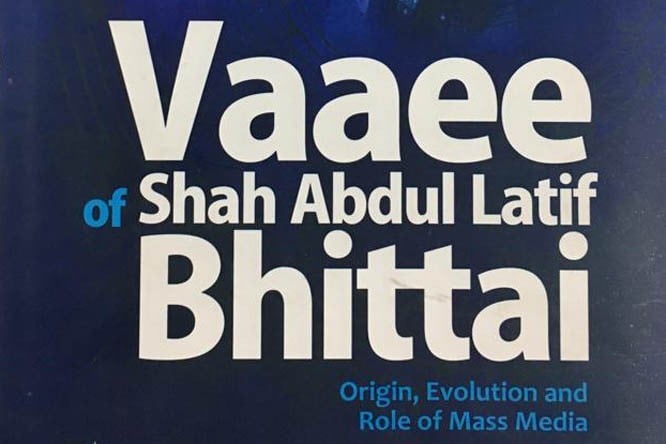
In his recently published book Zulfiqar Ali Qureshi captures the essence of vaaee by tracing its enrichment and evolution in Sindhi music

Zulfiqar Ali Qureshi has made an earnest effort to delink the poetical form of vaaee, the Sindhi folk music, from its musical one.
Many of our forms of poetry are also forms of music like ghazal, geet, kaafi, and considered to be one by the person in the street because it is assumed that music is poetry sung. In other words it serves no other purpose than to be illustrative of what the poetry implies.
On the contrary, the various formal traditions have emphasised the relationship of the note with the word. In more popular forms the two do have a tenuous relationship, though the styles of rendition have differed. Ghazal, as it has evolved over centuries, is a definitive form of music as indeed is kaafi -- and to unthinkingly link the two in some kind of an organic relationship is to be no more than boorish.
Vaaee means "to say, expression of inner voice, sorrowful and painful voice, a prayer or a curse". To many it was Shah Inayat who wrote vaaee for the first time in Sindhi literature. According to Dr Nabi Bakhsh Baloch, "Vaaee was sung in some style that caught the attention of the poets and became a part of classical literature… An interesting aspect of vaaee is that it is sung and written by popular and not so popular poets and singers".
Most of the scholars agree that vaaee was sung at the shrine of Shah Latif Bhittai in the form of music for the first time and so it has stayed as the prototype of the rendition of vaaee. In the absence of recording, it is very difficult to say what were the formal aspects and the evolutionary phases of singing vaaee -- because Shah Latif timeframe was 1619-1714, when Sindh came under the Mughal rule in Abkar’s reign. Shah Latif lived in the post-Akbar era, during the reigns of Jehangir, Shah Jehan, Aurangzeb, and died before the Sindhis started to assert themselves towards greater freedom by the middle of the 18th century with the declining power of the central court in Agra and Delhi.
The main concern of Zulfiqar Ali Qureshi has been the musical aspects of vaaee. He investigated to identify the various styles of its rendition over the centuries. Besides vaaee sung at the shrine of Shah Latif, he has labelled lok, soong, film, bhagat, dastaan goi, qawwali and the vaaee sung by Niaz Hussain and Allan Faqir as classical. He has himself also sung vaaee in the bara kheyal style which he claims to be his own contribution to this very venerated and peculiar form of Sindhi music.
Shah Latif Bhittai occupies a very special place among musicians or the music culture of Sindhis because he is also a naik who theoretically dwelled on the structure of music and identified 30 modes which he called surs and these have formed the theoretical backbone of all studies of music in that region. Some of these modes have formed the musical structure of the various melodies in which the various folktales of the area are rendered. It is a practice that is followed in other parts of the subcontinent, like Heer in the Punjab is invariably rendered in raag bhairaveen.
The most particularised style of singing the vaaee has been part of the ritual of Shah Latif’s shrine for as long as collective memory recalls. It is accompanied by the dhambori, an instrument that is also attributed to Shah Latif. In the group of four, Shah Jo Rag Fakirs have been singing the vaaee by placing themselves right in front of the door that leads to the sepulchre chamber. It is sung without rhythmic accompaniment, the latter is provided by the way the strings of the dhambori are struck or strummed. It is usually sung from dusk to dawn and sung continuously in the 72-hour duration of the urs.
The other forms of the area must have been influenced by formal structures, with the introduction of forms like dhrupad and kheyal, which were introduced during the Mughal rule and were further intensified with the shifting of the Punjabi gharana musicians in the late 18th and 19th century to the princely states in that area.
As the other forms have changed so has the way vaaee is sung. It proves that there is no special way in which poetry or lyrics are rendered -- they change according to the evolving musical forms. It is thus always very valuable to study art or art forms in relation to the cultural forces of history and the various changes that these bring along in the structure, intonation and ritual of performance.
Qureshi has mentioned the names of the vocalists with the vaaee numbers who have practiced this form and given it a distinct ang. All the major vocalists have added to its enriching and evolving style. Some of the various styles have been demonstrated in the CD that accompanies the book.
Qureshi is right; he does not lay down any prescribed manner in which the vaaee is supposed to be rendered and leaves it open in the light of the evolving nature of the musical form.
A hereditary musician, Qureshi has also studied music academically and carries a bachelor’s degree from the Department of Musicology, National College of Arts in Lahore, where he did most of his work on vaaee. He has been focusing on vaaee since then and has written this very valuable book on a musical form which adds significantly to the scant body of literature prevalent in our country.
Vaaee of Shah Abdul Latif Bhittai
Prof. Dr. Zulfiqar Ali Qureshi
Culture and Tourism Department – Government of Sindh
Pages 342
Price Rs 600